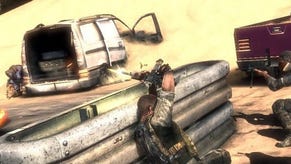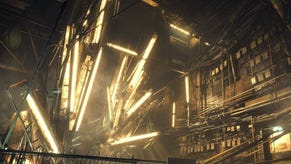Deus Ex: Human Revolution
The Revolution will not go unscrutinised.
This detail extends to another cyberpunk trope that the Human Revolution art designers have hit upon - the clutter that you could see in, say, Deckard's apartment or the building that toy-maker and stunted geneticist JF Sebastian inhabits in Blade Runner.
On both cases there's stuff piled everywhere, and it's clear that neither character knows the meaning of dusting. To this end in Human Revolution, alongside the wipe-clean veneer of a trans-humanist future, there will be heaps of fascinating stuff piled up on other fascinating stuff on most available surfaces.
There are between 1100 and 1300 different props in the game, each of them honed and designed to look like something that would be used (and useful) 17 years into the future: from microscopes and electro-photo frames all the way to cars and bus stops.
To add depth to this universe too, there will be a hundred different fictional in-game brands, whose logos you'll see everywhere - from the butt of your gun, to a flashing video-screen on the side of a skyscraper to the side of a cargo crate at the city docks.
Eidos Montreal truly is taking the trappings of near-future capitalism that science-fiction has been chuntering about for so long (Tyrell Corporation in Blade Runner, Weyland-Yutani in Alien etc.) and using them to bind together a seamless world in which you simply cannot sense the creative cracks.

As you make your way through this world your time will be split between combat, stealth, hacking and more social activities. Details on the former two are coming right up, although for more technical detail on the latter (and exactly what other ideas are coming and going into the design document) I urge you to read the developers' own thoughts on the subject, which we've gathered into a special "nerd thrills" roundup.
Essentially, however, hacking is a mini-game that borrows the spirit of Introversion's Uplink - with a mainframe searching you out as you dance between different nodes in a network of different connections, and with you using any augments you've collected to aid you in your unlock quest.
As for exchanging pleasantries, veiled threats and open threats with the people you meet, there'll be the usual question-and-answer sessions, but when you need to persuade a character, you will enter a game of verbal sparring.
Take the encounter with the barman in Shanghai's Hive nightclub for an example - a scarred, Asian 50-something with an augmented right hand. You're looking for and must correctly read your new friend's (quite brilliant) facial animation as you choose between 'pinpoint', 'insist' and 'threaten' from four different options.

It's a simplified process, but certainly an engaging one that you're forced to pay attention through - rather than jab the A button in an attempt to skip to the end. As it turns out, this chap actually is Tong - but in the turn of events I witnessed he was having none of it.
It took a code found in the toilets, some camera-dodging, a stealthy takedown of a patrolling guard, the carrying of his body to somewhere less obvious and a trek through some vents before Jensen heard what he needed to know. The hacker he was after was down at the docks. It was time to go and augment people in the face.
Down at the seafront, in the area where Heng Sha's massive freighters refuel, you're faced with one of the most utterly gobsmacking sights yet seen in gaming. The dual-layer city, as seen through a hazy gauze of residue fuel burning from the area's chimneys, is mind-blowing.
It soon becomes nothing but backdrop, however, as Jensen's stealth incursion to an enemy facility begins (although, clearly, the style of your grand entrance will entirely be up to you). What immediately becomes obvious is the seamless way in which the flicks from first- to third-person have been integrated - predominantly in the admittedly Gears-y way you can take cover, duck-run alongside said bullet-shield and then make a roll into the protection of sandbags/walls anew.












.png?width=291&height=164&fit=crop&quality=80&format=jpg&auto=webp)



